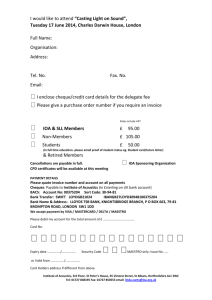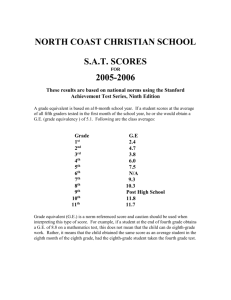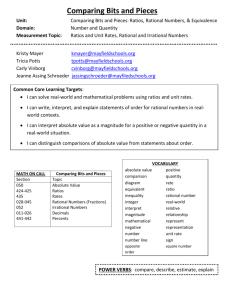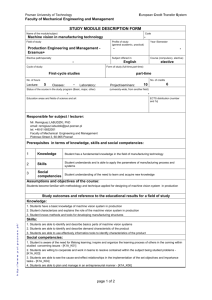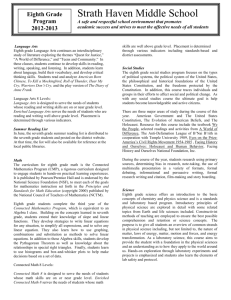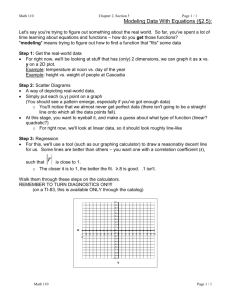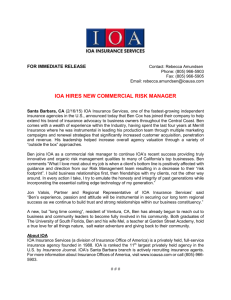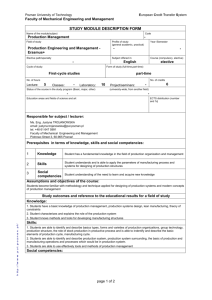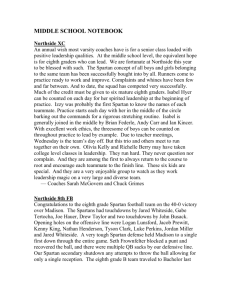8th Grade - Mulvane School District USD 263
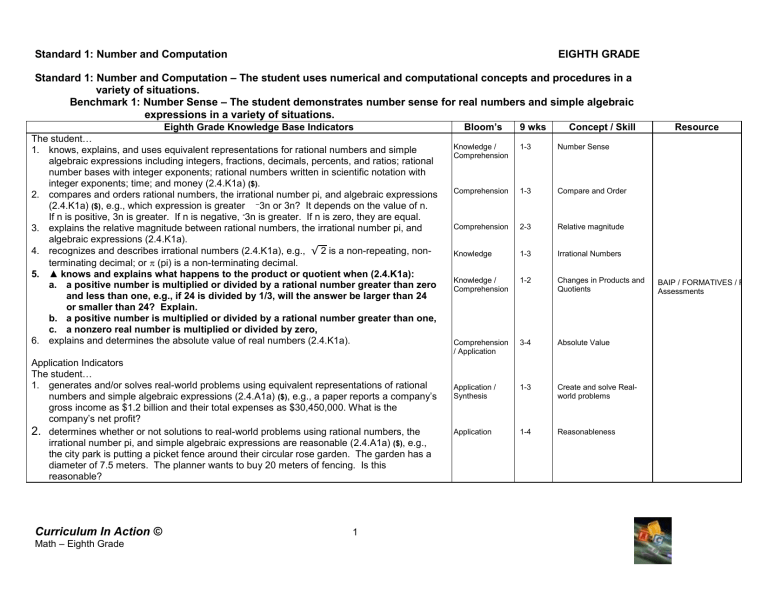
Standard 1: Number and Computation
Standard 1: Number and Computation – The student uses numerical and computational concepts and procedures in a variety of situations.
EIGHTH GRADE
Benchmark 1: Number Sense – The student demonstrates number sense for real numbers and simple algebraic
expressions in a variety of situations.
Eighth Grade Knowledge Base Indicators
The student…
1. knows, explains, and uses equivalent representations for rational numbers and simple algebraic expressions including integers, fractions, decimals, percents, and ratios; rational number bases with integer exponents; rational numbers written in scientific notation with integer exponents; time; and money (2.4.K1a) ($) .
2. compares and orders rational numbers, the irrational number pi, and algebraic expressions
(2.4.K1a) ($) , e.g., which expression is greater
–
3n or 3n? It depends on the value of n.
If n is positive, 3n is greater. If n is negative, 3n is greater. If n is zero, they are equal.
3. explains the relative magnitude between rational numbers, the irrational number pi, and algebraic expressions (2.4.K1a).
4. recognizes and describes irrational numbers (2.4.K1a), e.g.,
√
2 is a non-repeating, nonterminating decimal; or
(pi) is a non-terminating decimal.
5. ▲ knows and explains what happens to the product or quotient when (2.4.K1a): a. a positive number is multiplied or divided by a rational number greater than zero and less than one, e.g., if 24 is divided by 1/3, will the answer be larger than 24 or smaller than 24? Explain. b. a positive number is multiplied or divided by a rational number greater than one, c. a nonzero real number is multiplied or divided by zero,
6. explains and determines the absolute value of real numbers (2.4.K1a).
Application Indicators
The student…
1. generates and/or solves real-world problems using equivalent representations of rational numbers and simple algebraic expressions (2.4.A1a) ($)
, e.g., a paper reports a company’s gross income as $1.2 billion and their total expenses as $30,450,000. What is the company’s net profit?
2.
determines whether or not solutions to real-world problems using rational numbers, the irrational number pi, and simple algebraic expressions are reasonable (2.4.A1a) ($) , e.g., the city park is putting a picket fence around their circular rose garden. The garden has a
Bloom’s 9 wks
Knowledge /
Comprehension
Comprehension
Comprehension
Knowledge
Knowledge /
Comprehension
Comprehension
/ Application
Application /
Synthesis
Application
2-3
1-3
1-2
3-4
1-3
1-4
1-3
1-3
Concept / Skill
Number Sense
Compare and Order
Relative magnitude
Irrational Numbers
Changes in Products and
Quotients
Absolute Value
Create and solve Realworld problems
Reasonableness diameter of 7.5 meters. The planner wants to buy 20 meters of fencing. Is this reasonable?
Resource
BAIP / FORMATIVES / Formative
Assessments
Curriculum In Action ©
1
Math – Eighth Grade
Standard 1: Number and Computation EIGHTH GRADE
Standard 1: Number and Computation – The student uses numerical and computational concepts and procedures in a variety of situations.
Benchmark 2: Number Systems and Their Properties – The student demonstrates an understanding of the real
number system; recognizes, applies, and explains their properties; and extends these properties
to algebraic expressions.
Eighth Grade Knowledge Base Indicators
The student…
1. explains and illustrates the relationship between the subsets of the real number system
[natural (counting) numbers, whole numbers, integers, rational numbers, irrational numbers] using mathematical models (2.4.K1a), e.g., number lines or Venn diagrams.
2. ▲ identifies all the subsets of the real number system [natural (counting) numbers, whole numbers, integers, rational numbers, irrational numbers] to which a given number belongs (2.4.K1l). (For the purpose of assessment, irrational numbers will not be included.)
3. names, uses, and describes these properties with the rational number system and demonstrates their meaning including the use of concrete objects (2.4.K1a) ($) : a. commutative, associative, distributive, and substitution properties [commutative: a + b
= b + a and ab = ba; associative: a + (b + c) = (a + b) + c and a(bc) = (ab)c; distributive: a(b + c) = ab + ac; substitution: if a = 2, then 3a = 3 x 2 = 6]; b. identity properties for addition and multiplication and inverse properties of addition and multiplication (additive identity: a + 0 = a, multiplicative identity: a • 1 = a, additive inverse: + 5 +
–
5 = 0, multiplicative inverse: 8 x 1/8 = 1); c. symmetric property of equality, e.g., 7 + 2 = 9 has the same meaning as 9 = 7 + 2; d. addition and multiplication properties of equalities, e.g., if a = b, then a + c = b + c; e. addition property of inequalities, e.g., if a > b, then a + c > b + c; f. zero product property, e.g., if ab = 0, then a = 0 and/or b = 0.
Application Indicators
The student…
1. generates and/or solves real-world problems with rational numbers using the concepts of these properties to explain reasoning (2.4.A1a) ($) : a. ▲ commutative, associative, distributive, and substitution properties; e.g., we need to place trim around the outside edges of a bulletin board with dimensions of 3 ft by 5 ft. Explain two different methods of solving this problem and why the answers are equivalent. b. ▲ identity and inverse properties of addition and multiplication; e.g., I had $50. I
Bloom’s 9 wks
Application
Comp / Appl /
Eval
Analysis
Know / Appl
2-3
1-3
1-3
2-3
Concept / Skill
Subsets of real numbers
Subsets of real numbers
Number Properties
Number Properties
Curriculum In Action ©
2
Math – Eighth Grade
Resource
BAIP / FORMATIVES /
Formatives
BAIP / FORMATIVES /
Formatives
went to the mall and spent $20 in one store, $25 at a second store and then $5 at the food court. To solve: [$50 – ($20 + $25 + $5) = $50 - $50 = 0]. Explain your reasoning. c. symmetric property of equality; e.g., Sam took a $15 check to the bank and received a
$10 bill and a $5 bill. Later Sam took a $10 bill and a $5 bill to the bank and received a check for $15. $15 = $10 + $5 is the same as $10 + $5 = $15 d. addition and multiplication properties of equality; e.g., the total price (P) of a car, including tax (T), is $14, 685. 33. If the tax is $785.42, what is the sale price of the car
(S)? e. zero product property, e.g., Jenny was thinking of two numbers. Jenny said that the product of the two numbers was 0. What could you deduct from this statement?
Explain your reasoning
2. analyzes and evaluates the advantages and disadvantages of using integers, whole numbers, fractions (including mixed numbers), or decimals in solving a given real-world problem (2.4.A1a) ($) , e.g., in the store everything is 33 1/3% off. When calculating the discount, which representation of 33 1/3% would you use and why?
Anal / Eval 1-4 Advantages and
Disadvantages of
Number Properties
Curriculum In Action ©
3
Math – Eighth Grade
Standard 1: Number and Computation EIGHTH GRADE
Standard 1: Number and Computation – The student uses numerical and computational concepts and procedures in a variety of situations.
Benchmark 3: Estimation – The student uses computational estimation with real numbers in a variety of situations.
Eighth Grade Knowledge Base Indicators Bloom’s 9 wks Concept / Skill
The student…
Eval / App
1. estimates real number quantities using various computational methods including mental math,
1-4 Estimate with many methods paper and pencil, concrete objects, and/or appropriate technology (2.4.K1a) ($) .
2. uses various estimation strategies and explains how they were used to estimate real number quantities and simple algebraic expressions (2.4.K1a) ($) .
3. knows and explains why a decimal representation of the irrational number pi is an approximate value (2.4.K1c).
4. knows and explains between which two consecutive integers an irrational number lies
(2.4.K1a).
Application Indicators
The student…
1. adjusts original rational number estimate of a real-world problem based on additional information (a frame of reference) (2.4.A1a)
($)
, e.g., estimate the height of a building from a picture. In another picture, a person is standing next to the building. By using the person as a frame of reference adjust your original estimate.
2. estimates to check whether or not the result of a real-world problem using rational numbers and/or simple algebraic expressions is reasonable and makes predictions based on the information (2.4.A1a) ($) , e.g., you have a $4,000 debt on a credit card. You pay the minimum of $30 per month. Is it reasonable to pay off the debt in 10 years?
3. determines a reasonable range for the estimation of a quantity given a real-world problem and explains the reasonableness of the range (2.4.A1c) ($) , e.g., determine the reasonable range for the weight of a book and explain why this range is reasonable.
4. determines if a real-world problem calls for an exact or approximate answer and performs the appropriate computation using various computational methods including mental mathematics, paper and pencil, concrete objects, and/or appropriate technology (2.4.A1a) ($) , e.g., do you need an exact or an approximate answer when calculating the area of the walls in a room to determine the number of rolls of wallpaper needed to paper the room?. An approximation is appropriate for the area but an exact answer is needed for the number of roles. What would you do if you were wallpapering 2 rooms?
5. explains the impact of estimation on the result of a real-world problem (underestimate, overestimate, range of estimates) (2.4.A1a) ($) , e.g., you are estimating the total of three large purchases ($489, $553, and $92). If you rounded each to the nearest $10, would your estimate be slightly lower or higher than the actual amount spent? If you rounded each to the nearest
$100, would your estimate be slightly lower or higher than the actual amount spent?
Application
Application
Evaluation
Application
Know /
Comp
Evaluation
Application
Evaluation
1-4
1-4
1-4
1-4
3-4
2-4
1-4
1-4
Estimate with many methods
The number Pi
Irrational Numbers
Adjust estimates
Estimate
– check reasonableness
Estimate – check reasonableness
Exact vs. Approximate
Answer
Estimation
Resource
Curriculum In Action ©
4
Math – Eighth Grade
Standard 1: Number and Computation EIGHTH GRADE
Standard 1: Number and Computation – The student uses numerical and computational concepts and procedures in a variety of situations.
Benchmark 4: Computation – The student models, performs, and explains computation with rational numbers, the
irrational number pi, and algebraic expressions in a variety of situations.
Eighth Grade Knowledge Base Indicators
The student…
1. computes with efficiency and accuracy using various computational methods including mental math, paper and pencil, concrete objects, and appropriate technology (2.4.K1a) ($) .
2. performs and explains these computational procedures with rational numbers (2.4.K1a): a. ▲N addition, subtraction, multiplication, and division of integers b. ▲N order of operations (evaluates within grouping symbols, evaluates powers to the second or third power, multiplies or divides in order from left to right, then adds or subtracts in order from left to right); c. approximation of roots of numbers using calculators; d. multiplication or division to find: i. a percent of a number, e.g., what is 0.5% of 10? ii. percent of increase and decrease, e.g., if two coins are removed from ten coins, what is the percent of decrease? iii. percent one number is of another number, e.g., what percent of 80 is 120? iv. a number when a percent of the number is given, e.g., 15% of what number is 30? e. addition of polynomials, e.g., (3x – 5) + (2x + 8). f. simplifies algebraic expressions in one variable by combining like terms or using the distributive property (2.4.K1a), e.g., – 3(x
–
4) is the same as – 3x + 12.
3. finds factors and common factors of simple monomial expressions (2.4.K1d), e.g., given the monomials 10m 2 n 3 and 15a 2 mn 2 some common factors would be 5m, 5mn 2 , and n 2 .
Application Indicators
The student…
1. ▲ generates and/or solves one- and two-step real-world problems using computational procedures and mathematical concepts (2.4.A1a) with ($) : a. ■ rational numbers, e.g., find the height of a triangular garden given that the area to be covered is 400 square fe et with a base of 12½ feet; b. the irrational number pi as an approximation, e.g., before planting, a farmer plows a circular region that has an approximate area of 7,300 square feet. What is the radius of the circular region to the nearest tenth of a foot? c. applications of percents, e.g., sales tax or discounts. (For the purpose of assessment, percents greater than or equal to 100% will NOT be used).
Bloom’s 9 wk
Application
App / Eval
Knowledge
Synthesis /
Application
4
2-4
1-4
1-4
Concept / Skill
Variety of computational methods
Computation with
Integers and Order of
Operations
Monomials
One and Two step problems with area / circumference and percents
Resource
BAIP / Formatives
BAIP / Formatives
Curriculum In Action ©
5
Math – Eighth Grade
Standard 2: Algebra
Standard 2: Algebra – The student uses algebraic concepts and procedures in a variety of situations.
EIGHTH GRADE
Benchmark 1: Patterns – The student recognizes, describes, extends, develops, and explains the general rule
of a pattern from a variety of situations.
Eighth Grade Knowledge Base Indicators
The student…
1. identifies, states, and continues a pattern presented in various formats including numeric (list or table), algebraic (symbolic notation), visual (picture, table, or graph), verbal (oral description), kinesthetic (action), and written using these attributes : a. counting numbers including perfect squares, cubes, and factors and multiples with positive rational numbers (number theory) (2.4.K1a). b. rational numbers including arithmetic and geometric sequences (arithmetic: sequence of numbers in which the difference of two consecutive numbers is the same, geometric: a sequence of numbers in which each succeeding term is obtained by multiplying the preceding term by the same number) (2.4.K1a), e.g., 1, 1, 3 , …;
4 2 4 c. geometric figures (2.4.K1h); d. measurements (2.4.K1a); e. things related to daily life ($) ; f. variables and simple expressions, e.g., 1 – x, 2 – x, 3 – x, 4 – x, ...; or x, x 2 , x 3 , ...
2. generates and explains a pattern (2.4.K1a).
3. generates a pattern limited to two operations (addition, subtraction, multiplication, division, exponents) when given the rule for the nth term (2.4.K1a), e.g., the n th term is n 2 +1, find the first
4 terms beginning with n = 1; the terms are 2, 5, 10, and 17.
4. states the rule to find the nth term of a pattern using explicit symbolic notation (2.4.K1a), e.g., given 2, 5, 8, 11, …; find the rule for the nth term, the rule is 3n –1.
5. describes the pattern when given a table of linear values and plots the ordered pairs on a coordinate plane (2.4.K1f-g), e.g., in the table below, the pattern could be described as the xcoordinates are increasing by three, while the y-coordinates are increasing by 6, or the x is doubled and one is added to find the y.
X
Y
2
5
5
11
8
17
11
23
Comp /
Know
Syn / Eval
Synthesis
Knowledge
Knowledge
Bloom’s 9 wks Concept / Skill
1-3
1-3
1-3
1-4
1-3 Patterns
Create / Explain patterns
Pattern
– Nth term
Rule – Nth term
Pattern using table of values
Curriculum In Action ©
6
Math – Eighth Grade
Resource
Application Indicators
The student…
1. generalizes numerical patterns using algebra and then translates between the equation, graph, and table of values resulting from the generalization (2.4.A1d-e,j)
($)
, e.g., water is billed at
$1.00 per 1,000 gallons, plus a basic fee of $10 per month for being connected to the water district.
1,000 Gallons | Cost in a given month Graph these:
1 | $10 + 1*1.00 (1, 11)
2 | $10 + 2*.1.00 (2, 12)
. | .
. | .
n | 10 + n*1.00 (n, 1.00n + 10) where C = total cost and G = gallons used,
C = 1.00 G + 10]
(Title/Labels needed)
2. recognizes the same general pattern presented in different representations [numeric (list or table), visual (picture, table, or graph), and written] (2.4.A1a,j) ($) .
Curriculum In Action ©
7
Math – Eighth Grade
Bloom’s 9 wks Concept / Skill Resource
2-4
2-4
Knowledge
Comp Patterns translated to equations and graphs
Recognize pattern from different representations
Standard 2: Algebra
Standard 2: Algebra – The student uses algebraic concepts and procedures in a variety of situations.
EIGHTH GRADE
Benchmark 2: Variable, Equations, and Inequalities – The student uses variables, symbols, real numbers, and
algebraic expressions to solve equations and inequalities in a variety of situations.
Eighth Grade Knowledge Base Indicators
The student…
1. identifies independent and dependent variables within a given situation.
2. simplifies algebraic expressions in one variable by combining like terms or using the distributive property (2.4.K1a), e.g.,
–
3(x – 4) is the same as –
3 x + 12.
3. solves (2.4.K1a,e) ($): a. ▲ one- and two-step linear equations in one variable with rational number coefficients and constants intuitively and/or analytically; b. one-step linear inequalities in one variable with rational number coefficients and constants intuitively, analytically, and graphically; c. systems of given linear equations with whole number coefficients and constants graphically.
4. knows and describes the mathematical relationship between ratios, proportions, and percents and how to solve for a missing monomial or binomial term in a proportion (2.4.K1c), e.g., 2 =
_ 1_
5 x + 2.
5. represents and solves algebraically ($) : a. the number when a percent and a number are given, b. what percent one number is of another number, c. percent of increase or decrease, e.g., the price of a loaf of bread is $2.00. With a coupon, the cost is $1.00. What is the percent of decrease?
6. evaluates formulas using substitution ($) .
Application Indicators
The student…
1. represents real-world problems using (2.4.A1d) ($) : a. ▲ ■ variables, symbols, expressions, one- or two-step equations with rational number coefficients and constants, e.g., today John is 3.25 inches more than half his sister’s height. If J = John’s height, and S = his sister’s height, then J = 0.5S +
3.25. b. one-step inequalities with rational number coefficients and constants, e.g., after Randy paid $38.50 for a watch, he did not have enough money to by a calculator for $5.50.
Bloom’s 9 wk
Evaluation
Comp
Comp.
Synthesis
Application
Know / Comp
App / Comp
1-4
2-4
2-4
2-4
3-4
2-4
2-4
Concept / Skill
Independent /
Dependent variables
Combining like terms
One and Two step linear equations
Ratios/ Proportions /
Percents
Solving Percent
Equations
Substitution Property
Real-world Equations /
Inequalities
Curriculum In Action ©
8
Math – Eighth Grade
Resource
BAIP / FORMATIVES
BAIP / FORMATIVES
Represent this situation with an inequality. c. systems of linear equations with whole number coefficients and constants, e.g., two students collected the same amount of money for a walk-a-thon. One student received $5 per mile and a donation of $10, while the other student received $2 per mile and a donation of $20. How many miles did they walk?
2. solves real-world problems with two-step linear equations in one variable with rational number coefficients and constants and rational solutions intuitively, analytically, and graphically
(2.4.A1e) e.g., Mike and Albert are friends, but Joe and Albert are not friends. Which of the following diagrams can be used to describe this situation? (Three dots labeled J, M, A: there is a line between J and M and line between M and A, but no line between J and A.)
3. generates real-world problems that represent (2.4.A1d) ($) : a. one- or two-step linear equations, ($) , e.g., given the equation 2x + 10 = 30, the problem could be I bought two shirts and a pair of pants for $10. How much was a shirt, if the total bill was $30? b. one-step linear inequalities, e.g., write a real-world situation that represents the inequality x + 10 > 30. The problem could be: If you give me $10, I will have more than $30.
4. explains the mathematical reasoning that was used to solve a real-world problem using one- or two-step linear equations and inequalities and discusses the advantages and disadvantages to various strategies that may have been used to solve the problem, (2.4.A1d) ($) , e.g., given the inequality x + 10 > 30, subtract the same number from both sides of the inequality or graph as y1
= x + 10 and y = 30 and find on the graph where y1 is less than y2. The first method gives an exact answer; the second method is a visual representation and can be used to solve more difficult inequalities.
Application
Synthesis
Syn / Eval
3-4
3-4
3-4 Real-world 2-step linear equations
Real-world 2-step linear equations
Real-world 2-step linear equations
Curriculum In Action ©
9
Math – Eighth Grade
Standard 2: Algebra
Standard 2: Algebra – The student uses algebraic concepts and procedures in a variety of situations.
EIGHTH GRADE
Benchmark 3: Functions – The student recognizes, describes, and analyzes constant, linear, and nonlinear
relationships in a variety of situations.
Eighth Grade Knowledge Base Indicators Bloom’s
9 wks
Concept / Skill
The student…
1. recognizes and examines constant, linear, and nonlinear relationships using various methods including mental math, paper and pencil, concrete objects, and graphing utilities or appropriate technology (2.4.K1a,e-g) ($) .
2. knows and describes the difference between constant, linear, and nonlinear relationships
(2.4.K1g).
3. explains the concepts of slope and x- and y-intercepts of a line (2.4.K1g).
4. recognizes and identifies the graphs of constant and linear functions (2.4.K1g) ($) .
5. identifies ordered pairs from a graph, and/or plots ordered pairs using a variety of scales for the x- and y-axis (2.4.K1g).
Application Indicators
The student…
1. represents a variety of constant and linear relationships using written or oral descriptions of the rule, tables, graphs, and symbolic notation (2.4.A1d-f) ($) .
2. interprets, describes, and analyzes the mathematical relationships of numerical, tabular, and graphical representations (2.4.A1j) ($) .
3. ▲ translates between the numerical, tabular, graphical, and symbolic representations of linear relationships with integer coefficients and constants (2.4.A1a), e.g., a fish tank is being filled with water with a 2-liter jug.
There are already 5 liters of water in the fish tank. Therefore, you are showing how full the tank is as you empty 2-liter jugs of water into it.
Y = 2x + 5 (symbolic) can be represented in a table (tabular)
–
X 0 1 2 3
Y 5 7 9 1
1
and as a graph (graphical) –
Know / App
Know / comp
Comp / Anal
Know / Comp
Comp / Anl
Comp
Comp / Anal
Comp
2-4
2-4
2-4
2-4
1-4
2-4
2-4
2-4
Constant, linear, nonlinear relationships
Constant, linear, nonlinear relationships
Slope
Constant, linear funct.
Plot ordered pairs
Constant and linear relationships
Numerical, tabular and graphical represent.
Numerical, tabular and graphical represent.
Resource
BAIP / FORMATIVES
Curriculum In Action ©
10
Math – Eighth Grade
Standard 2: Algebra
Standard 2: Algebra – The student uses algebraic concepts and procedures in a variety of situations.
EIGHTH GRADE
Benchmark 4: Models – The student generates and uses mathematical models to represent and justify mathematical relationships found in a variety of situations.
Eighth Grade Knowledge Base Indicators
The student…
1. knows, explains, and uses mathematical models to represent and explain mathematical concepts, procedures, and relationships.
Mathematical models include: a. process models (concrete objects, pictures, diagrams, number lines, hundred charts, measurement tools, multiplication arrays, division sets, or coordinate grids) to model computational procedures, algebraic relationships, and mathematical relationships and to solve equations (1.1.K1-6, 1.2.K1, 1.2.K3, 1.3.K1-2, 1.3.K4, 1.4.K1-2, 2.1.K1a-b, 2.1.K1de, 2.1.K2-4, 2.2.K2-3, 3.1.K9, 3.2.K1-4, 3.3.K1-4, 3.4.K4, 4.2.K4-5) ($) ; b. place value models (place value mats, hundred charts, base ten blocks, or unifix cubes) to compare, order, and represent numerical quantities and to model computational procedures ($) ; c. fraction and mixed number models (fraction strips or pattern blocks) and decimal and money models (base ten blocks or coins) to compare, order, and represent numerical quantities (1.3.K3, 2.3.K6) ($) : d. factor trees to model least common multiple, greatest common factor, and prime factorization (1.4.K3); e. equations and inequalities to model numerical relationships (2.2.K3, (3.4.K2) ($) ; f. function tables to model numerical and algebraic relationships (2.1.K5, 3.4.K2)
($)
; g. coordinate planes to model relationships between ordered pairs and linear equations and inequalities (2.1.K5, 2.3.K1-5, 3.4.K2-3) ($) ; h. two- and three-dimensional geometric models (geoboards, dot paper, nets, or solids) and real-world objects to model perimeter, area, volume, surface area, and properties of twoand three-dimensional figures (2.1.K1c, 3.1.K1-6, 3.1.K8, 3.1.K10, 3.2.K5, 3.3.K4-5); i. scale drawings to model large and small real-world objects (3.3.K3-4); j. geometric models (spinners, targets, or number cubes), process models (coins, pictures, or diagrams), and tree diagrams to model probability (4.1.K1-5) ($) ;
Bloom’s 9wks Concept / Skill
Know / Comp
/ Anal
1-4 Mathematical Models
Resource
Curriculum In Action ©
11
Math – Eighth Grade
k. frequency tables, bar graphs, line graphs, circle graphs, Venn diagrams, charts, tables, single and double stem-and-leaf plots, scatter plots, box-and-whisker plots, and histograms to organize and display data (4.2.K1, 4.2.K6) ($) ; l. Venn diagrams to sort data and to show relationships (1.2.K2).
Application Indicators
The student…
1. recognizes that various mathematical models can be used to represent the same problem situation. Mathematical models include: a. process models (concrete objects, pictures, diagrams, flowcharts, number lines, hundred charts, measurement tools, multiplication arrays, division sets, or coordinate grids) to model computational procedures, algebraic relationships, mathematical relationships, and problem situations and to solve equations (1.1.A1-2, 1.2.A1-2, 1.3.A1-5, 1.4.A1, 2.1.A1, 3.1.A1, 3.2.A1-
2, 3.3.A1, 3.4.A1-2) ($) ; a. place value models (place value mats, hundred charts, base ten blocks, or unifix cubes) to model problem situations ($) ; b. fraction and mixed number models (fraction strips or pattern blocks) and decimal and money models (base ten blocks or coins) to compare, order, and represent numerical quantities (3.2.A3) ($) ; c. equations and inequalities to model numerical relationships
( 2.1.A2, 2.2.A1-2, 2.3.A1, 3.4.A2) ($) ; d. function tables to model numerical and algebraic relationships (2.1.A2, 2.3.A2, 3.4.A2) ($) ; e. coordinate planes to model relationships between ordered pairs and linear equations and inequalities (2.3.A1 3.4.A2) ($) ; f. two- and three-dimensional geometric models (geoboards, dot paper, nets, or solids) and real-world objects to model perimeter, area, volume, surface area and properties of two- and three-dimensional figures (3.3.A3, 3.4.A2); scale drawings to model large and small real-world objects (3.1.A1-2, 3.3.A4); g. geometric models (spinners, targets, or number cubes), process models (coins, pictures, or diagrams), and tree diagrams to model probability (4.1.A1-4); j. frequency tables, bar graphs, line graphs, circle graphs, Venn diagrams, charts, tables, single and double stem-and-leaf plots, scatter plots, box-and-whisker plots, and histograms to describe, interpret, and analyze data (2.1.A1-2, 2.3.A2-3, 4.2.A1, 4.2.A3, 4.2.A1-3) ($) ; k. Venn diagrams to sort data and to show relationships.
2. ▲ determines if a given graphical, algebraic, or geometric model is an accurate representation of a given real-world situation ($).
3. uses the mathematical modeling process to analyze and make inferences about real-world situations ($) .
Curriculum In Action ©
12
Math – Eighth Grade
Blooms 9 wks Concept / Skill
Knowledge
Application
Application
1-4
1-4
1-4
Mathematical Models
Models for real-world situations
Models for real-world situations
Resource
BAIP / FORMATIVES
Standard 3: Geometry EIGHTH GRADE
Standard 3: Geometry – The student uses geometric concepts and procedures in a variety of situations.
Benchmark 1: Geometric Figures and Their Properties – The student recognizes geometric figures and compares
their properties in a variety of situations.
Eighth Grade Knowledge Base Indicators
The student…
1. recognizes and compares properties of two- and three-dimensional figures using concrete objects, constructions, drawings, appropriate terminology, and appropriate technology
(2.4.K1h).
2. discusses properties of triangles and quadrilaterals related to (2.4.K1h): a. sum of the interior angles of any triangle is 180 ° ; b. sum of the interior angles of any quadrilateral is 360 ° ; c. parallelograms have opposite sides that are parallel and congruent, opposite angles are congruent; d. rectangles have angles of 90°, sides may or may not be equal; e. rhombi have all sides equal in length, angles may or may not be equal; f. squares have angles of 90°, all sides congruent; g. trapezoids have one pair of opposite sides parallel and the other pair of opposite sides are not parallel; h. kites have two distinct pairs of adjacent congruent sides.
3. recognizes and describes the rotational symmetries and line symmetries that exist in twodimensional figures (2.4.K1h), e.g., draw a picture with a line of symmetry in it. Explain why it is a line of symmetry.
4. recognizes and uses properties of corresponding parts of similar and congruent triangles and quadrilaterals to find side or angle measures using standard notation for similarity (~) and congruence (
) (2.4.K1h).
5. knows and describes Triangle Inequality Theorem to determine if a triangle exists
(2.4.K1h).
6. ▲ uses the Pythagorean theorem to (2.4.K1h): a. determine if a triangle is a right triangle, b. find a missing side of a right triangle where the lengths of all three sides are whole numbers.
7. recognizes and compares the concepts of a point, line, and plane.
8. describes the intersection of plane figures, e.g., two circles could intersect at no point, one point, two points, or all points.
9. describes and explains angle relationships: a. when two lines intersect including vertical and supplementary angles; b. when formed by parallel lines cut by a transversal including corresponding, alternate interior, and alternate exterior angles.
Bloom’s 9wks Concept / Skill
Know /
Comp
Know
Know /
Anal
Comp
Know /
Comp
Appl
Comp /
Anal
Comp /
Anal
Eval and
Syn
2-4
1-4
2-4
2-4
4
3-4
1-4
4
4
Properties of 2 and 3 dimensional figures
Properties of
Triangles and
Quadrilaterals
Symmetry
Corresponding
Parts of Triangles &
Quads
Triangle Inequal
Theorem
Pythagorean
Theorem
Point, Line, Plane
Intersection of Plane figures
Angle Relationships
Resource
BAIP /
Formatives
Curriculum In Action ©
13
Math – Eighth Grade
10. recognizes and describes arcs and semicircles as parts of a circle and uses the standard notation for arc (
) and circle ( ) (2.4.K1h).
Application Indicators
The student…
1. solves real-world problems by (2.4.A1a): a. ▲ ■ using the properties of corresponding parts of similar and congruent figures, e.g., scale drawings, map reading, proportions, or indirect measurements. b. applying the Pythagorean Theorem, e.g., indirect measurements, map reading/distance, or diagonals.
Know /
Comp
App
4
2-4
Arcs and
Semicircles
Real-world problems with corresponding parts and
Pythagorean
Theorem
BAIP /
Formatives
Curriculum In Action ©
14
Math – Eighth Grade
Standard 3: Geometry EIGHTH GRADE
Standard 3: Geometry – The student uses geometric concepts and procedures in a variety of situations.
Benchmark 2: Measurement and Estimation – The student estimates, measures, and uses geometric formulas in a
variety of situations.
Eighth Grade Knowledge Base Indicators
The student…
1. determines and uses rational number approximations (estimations) for length, width, weight, volume, temperature, time, perimeter, area, and surface area using standard and nonstandard units of measure (2.4.K1a) ($) .
2. selects and uses measurement tools, units of measure, and level of precision appropriate for a given situation to find accurate real number representations for length, weight, volume, temperature, time, perimeter, area, surface area, and angle measurements (2.4.K1a) ($) .
3. converts within the customary system and within the metric system.
4. estimates the measure of a concrete object in one system given the measure of that object in another system and the approximate conversion factor (2.4.K1a), e.g., a mile is about 2.2 kilometers; how far is 2 miles?
5. uses given measurement formulas to find (2.4.K1h): a. area of parallelograms and trapezoids; b. surface area of rectangular prisms, triangular prisms, and cylinders; c. volume of rectangular prisms, triangular prisms, and cylinders.
6. recognizes how ratios and proportions can be used to measure inaccessible objects (2.4.K1c), e.g., using shadows to measure the height of a flagpole.
7. calculates rates of change, e.g., speed or population growth.
Application Indicators
The student…
1. solves real-world problems (2.4.A1a) by ($) : a. converting within the customary and the metric systems, e.g., James added 30 grams of sand to his model boat that weighed 2 kg before it sank. With the sand included, what is the total weight of his boat? b. finding perimeter and area of circles, squares, rectangles, triangles, parallelograms, and trapezoids; e.g., Jane jogs on a circular track with a radius of 100 feet. How far would she jog in one lap? c. finding the volume and surface area of rectangular prisms, e.g., how much paint would be needed to cover a box with dimensions of 3 feet by 4 feet by 5 feet?
2-4
3-4
2-4
4
1-4
1-4
1-4
1-4
Bloom’s 9 wk Concept / Skill
Application
Eval / App
Application
Comp.
Evaluation
Application
Knowledge
Comp / App
Estimation
Appropriate measurement tools
Conversion
– metric to customary
Estimates with metric and customary
Measurement formulas
Measure with ratios and proportions
Rates of change
Real-world conversions
– metric and customary
Curriculum In Action ©
15
Math – Eighth Grade
Resource
2. estimates to check whether or not measurements or calculations for length, weight, volume, temperature, time, perimeter, area, and surface area in real world problems are reasonable and adjusts original measurement or estimation based on additional information (a frame of reference) (2.4.A1a) ($) , e.g., to check your calculation in finding the area of the floor in the kitchen; you count how many foot-square tiles there are on the floor.
3. uses ratio and proportion to measure inaccessible objects (2.4.A1c), e.g., using the length of a shadow to measure the height of a flagpole.
Evaluation
Application
1-4
2-4
Estimate to check reasonableness of measurements
Using Ratios and
Proportions to measure
Curriculum In Action ©
16
Math – Eighth Grade
Standard 3: Geometry EIGHTH GRADE
Standard 3: Geometry – The student uses geometric concepts and procedures in a variety of situations.
Benchmark 3: Transformational Geometry – The student recognizes and applies transformations on geometric
figures in a variety of situations.
Eighth Grade Knowledge Base Indicators
The student…
1. identifies, describes, and performs single and multiple transformations [reflection, rotation, translation, reduction (contraction/shrinking), enlargement (magnification/growing)] on a twodimensional figure (2.4.K1a).
2. describes a reflection of a given two-dimensional figure that moves it from its initial placement
(preimage) to its final placement (image) in the coordinate plane over the x- and y-axis (2.4.K1a,i).
3. draws (2.4.K1a): a. three-dimensional figures from a variety of perspectives (top, bottom, sides, corners); b. a scale drawing of a two-dimensional figure; c. a two-dimensional drawing of a three-dimensional figure.
4. determines where and how an object or a shape can be tessellated using single or multiple transformations (2.4.K1a).
Application Indicators
The student…
1. generalizes the impact of transformations on the area and perimeter of any two-dimensional geometric figure (2.4.A1a), e.g., enlarging by a factor of three triples the perimeter (circumference) and multiplies the area by a factor of nine.
2. describes and draws a two-dimensional figure after undergoing two specified transformations without using a concrete object.
3. investigates congruency, similarity, and symmetry of geometric figures using transformations
(2.4.A1g).
4. uses a scale drawing to determine the actual dimensions and/or measurements of a twodimensional figure represented in a scale drawing (2.4.A1h).
Bloom’s 9 wks Concept / Skill Resource
4
3 & 4
4
4
4
4
3 & 4
3 & 4
Know / App
Comp /
Know
Application
Application
Comp
Comp /
Know
Analysis
Application
Transformations
Reflections
Drawing 2 & 3 dimensional figures
Tessellations
How transformations affect area & perimeter
Describe transformations
Congruency, similarity, symmetry
Scale drawings
Curriculum In Action ©
17
Math – Eighth Grade
Standard 3: Geometry EIGHTH GRADE
Standard 3: Geometry – The student uses geometric concepts and procedures in a variety of situations.
Benchmark 4: Geometry from an Algebraic Perspective – The student uses an algebraic perspective to examine the
geometry of two-dimensional figures in a variety of situations.
Eighth Grade Knowledge Base Indicators
The student…
1. uses the coordinate plane to (2.4.K1a): a. ▲ list several ordered pairs on the graph of a line and find the slope of the line; b. ▲ recognize that ordered pairs that lie on the graph of an equation are solutions to that equation; c. ▲ recognize that points that do not lie on the graph of an equation are not solutions to that equation; d. ▲ determine the length of a side of a figure drawn on a coordinate plane with vertices having the same x- or y-coordinates; e. solve simple systems of linear equations.
2. uses a given linear equation with integer coefficients and constants and an integer solution to find the ordered pairs, organizes the ordered pairs using a T-table, and plots the ordered pairs on a coordinate plane (2.4.K1e-g).
3. examines characteristics of two-dimensional figures on a coordinate plane using various methods including mental math, paper and pencil, concrete objects, and graphing utilities or other appropriate technology (2.4.A1g).
Application Indicators
The student…
1. represents, generates, and/or solves distance problems (including the use of the
Pythagorean theorem, but not necessarily the distance formula) (2.4.A1a), e.g., a student lives five miles west and three miles north of school and another student lives
4 miles south and 7 miles east of school. What is the shortest distance between the stu dents’ homes (as the crow flies)?
2. translates between the written, numeric, algebraic, and geometric representations of a real-world problem (2.4.A1a,d-g), e.g., given a situation: make a T-table, define the algebraic relationship, and graph the ordered pairs. The T-table can be represented as – as an algebraic relationship – 2 χ = 5,
X 0 1 2 3
Y 5 7 9 11
Bloom’s
Application
Application
Analysis
Comp / Syn /
App
Comp
9 wk
3 & 4
3 & 4
2-4
3 & 4
2-4
Concept / Skill
Coordinate plane / slope
Linear equations
– finding ordered pairs
2 – dimensional figures on a coordinate plane
Distance problems
Translates between different types of representations
Resource
BAIP / FORMATIVES
Curriculum In Action ©
18
Math – Eighth Grade
Standard 4: Data EIGHTH GRADE
Standard 4: Data – The student uses concepts and procedures of data analysis in a variety of situations.
Benchmark 1: Probability – The student applies the concepts of probability to draw conclusions, generate
convincing arguments, and make predictions and decisions including the use of concrete objects in a
variety of situations.
Eighth Grade Knowledge Base Indicators
The stud ent…
1. knows and explains the difference between independent and dependent events in an experiment, simulation, or situation (2.4.K1j) ($) .
2. identifies situations with independent or dependent events in an experiment, simulation, or situation (2.4.K1j), e.g., there are three marbles in a bag. If you draw one marble and give it to your brother, and another marble and give it to your sister, are these independent events or dependent events?
3. ▲ finds the probability of a compound event composed of two independent events in an experiment, simulation, or situation (2.4.K1j), e.g., what is the probability of getting two heads, if you toss a dime and a quarter?
4. finds the probability of simple and/or compound events using geometric models (spinners or dartboards) (2.4.K1j).
5. finds the odds of a desired outcome in an experiment or simulation and expresses the answer as a ratio (2/3 or 2:3 or 2 to 3) (2.4.K1j).
6. describes the difference between probability and odds.
Application Indicators
The student…
1. conducts an experiment or simulation with independent or dependent events including the use of concrete objects; records the results in a chart, table, or graph; and uses the results to draw conclusions and make predictions about future events (2.4.A1i-j).
2. analyzes the results of an experiment or simulation of two independent events to generate convincing arguments, draw conclusions, and make predictions and decisions in a variety of real-world situations (2.4.A1i-j) .
3. compares theoretical probability (expected results) with empirical probability (experimental results) in an experiment or simulation with a compound event composed of two independent events and understands that the larger the sample size, the greater the likelihood that the experimental results will equal the theoretical probability (2.4.A1i).
4. makes predictions based on the theoretical probability of (2.4.A1a,i): a. ▲ a simple event in an experiment or simulation, b. compound events composed of two independent events in an experiment or simulation.
Bloom’s 9 wk
Know / Comp and Anal
Know / Comp
Knowledge
Knowledge
Knowledge
Know / Comp
Application
Application
Comp / Anal
Comp / App
1-4
2-4
4
4
3 & 4
1-4
1-4
3 & 4
3 & 4
3 & 4
Concept / Skill
Independent / Dependent
Events
Independent / Dependent
Events
Probability – compound event
Probability – compound event
Odds
Difference between probability and odds
Conducts experiments
Analyze results of experiments
Theoretical vs.
Experimental Probability
Makes predictions
Resource
BAIP /
FORMATIVES
BAIP /
FORMATIVES
Curriculum In Action ©
19
Math – Eighth Grade
Standard 4: Data EIGHTH GRADE
Standard 4: Data – The student uses concepts and procedures of data analysis in a variety of situations.
Benchmark 2: Statistics – The student collects, organizes, displays, explains, and interprets numerical (rational) and
non-numerical data sets in a variety of situations.
Eighth Grade Knowledge Base Indicators
The student…
1. organizes, displays and reads quantitative (numerical) and qualitative (non-numerical) data in a clear, organized, and accurate manner including a title, labels, categories, and rational number intervals using these data displays (2.4.K1k) ($) : a. frequency tables; b. bar, line, and circle graphs; c. Venn diagrams or other pictorial displays; d. charts and tables; e. stem-and-leaf plots (single and double); f. scatter plots; g. box-and-whiskers plots; h. histograms.
2. recognizes valid and invalid data collection and sampling techniques.
3. ▲ determines and explains the measures of central tendency (mode, median, mean) for a rational number data set (2.4.K1a).
4. determines and explains the range, quartiles, and interquartile range for a rational number data set (2.4.K1a).
5. explains the effects of outliers on the median, mean, and range of a rational number data set
(2.4.K1a).
6. makes a scatter plot and draws a line that approximately represents the data, determines whether a correlation exists, and if that correlation is positive, negative, or that no correlation exists (2.4.K1k).
Application Indicators
The student…
1. uses data analysis (mean, median, mode, range) in real-world problems with rational number data sets to compare and contrast two sets of data, to make accurate inferences and predictions, to analyze decisions, and to develop convincing arguments from these data displays (2.4.A1j) ($) : a. frequency tables; b. bar, line, and circle graphs; c. Venn diagrams or other pictorial displays; d. charts and tables; e. stem-and-leaf plots (single and double);
Bloom’s 9 wk
App / Syn
Know
Eval / Syn
Eval / Syn
Syn / Eval
Application
Application 4
3 & 4
4
4
2-4
3 & 4
1-4
Concept / Skill
Data displays
Valid / Invalid techniques
Mean, median, mode
Quartiles range
Outliers
Scatter plots
Compare / contrast data sets
Resource
BAIP / Formatives
Curriculum In Action ©
20
Math – Eighth Grade
f. scatter plots; g. box-and-whiskers plots; h. histograms.
2. explains advantages and disadvantages of various data collection techniques (observations, surveys, or interviews), and sampling techniques (random sampling, samples of convenience, biased sampling, or purposeful sampling) in a given situation (2.4.A1j) ($) .
3. recognizes and explains (2.4.A1j): a. misleading representations of data; b. the effects of scale or interval changes on graphs of data sets.
recognizes faulty arguments and common errors in data analysis.
Syn / Eval
Know / Syn and Eval
4
4
Advantages / disadvantages of data collection techniques
Misleading representations of data
Curriculum In Action ©
21
Math – Eighth Grade
